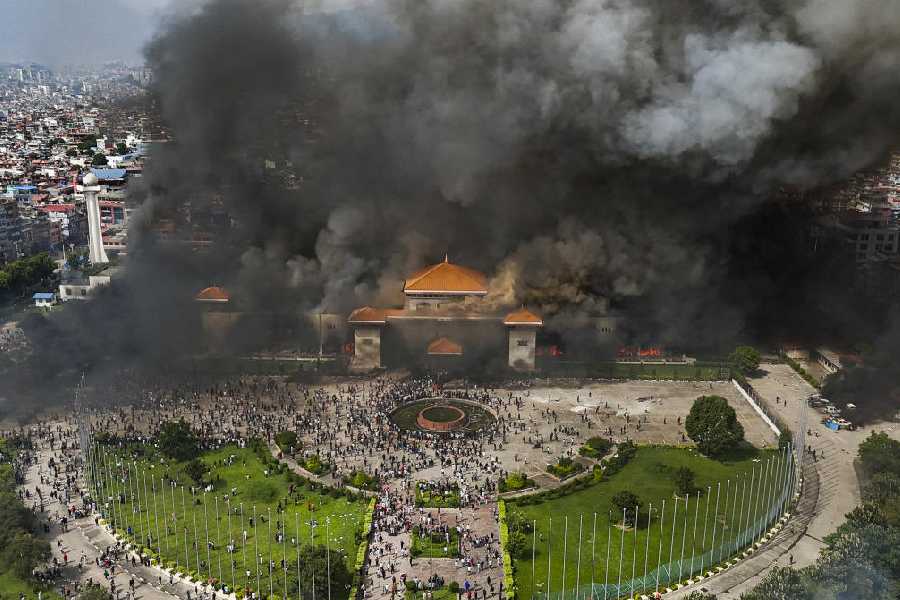Dec. 24: Words like unguided missiles have raised the spectre of an air war between India and Pakistan.
Pakistan’s fighter aircraft are forward deployed and are flying ear-shattering sorties over its major cities, creating a war hysteria among its public.
In India, a preparation for the worst is not accompanied by a declaration of intent for hostilities. But the chief of the Indian Air Force’s largest command today chose to claim that the IAF is capable of hitting “5,000 targets” in Pakistan.
“The IAF has earmarked 5,000 targets in Pakistan. But whether we will cross the LoC or the International Border to hit the enemy targets will have to be decided by the political leadership of the country,” P.K. Barbora, the air officer commanding-in-chief of Western Air Command, said in Guwahati today
The words evoked shock and awe among diplomats because the political leadership is signalling otherwise. Air headquarters in New Delhi may still tamp down what Barbora has had to say. But that is in the very nature of brinkmanship.
It is now time for bluster, not boom-boom.
It is apt. Inside the defence ministry in South Block, army, navy and air force officers display letters and postcards from citizens who are praising the armed forces and are urging war. Some of the postcards are colourful with “Attack Pakistan” written in bold capital letters.
The remarks of Barbora, the decorated, chain-smoking officer, are in keeping with the mood that is gripping the military. They do not constitute a call to arms.
“Air power is lethal and escalatory and is therefore to be used with great caution,” said Air Marshal (retired) Padamjit Singh “Pudding” Ahluwalia, Barbora’s immediate predecessor as the Western Air Command chief. “And war plans are based on objectives. What kind of objective you must have is the crucial decision that has to be handed down. Ideally, you must have the capability to defeat the adversary’s will to fight,” he added.
There is little evidence that the Cabinet Committee on Security has given a directive to the military to ready for an offensive and, indeed, what kind of target that offensive should seek to achieve. Barbora’s comments today do not reflect that he has got a directive.
The area of responsibility of the Western Air Command is from Kashmir to Rajasthan — almost the entire frontage of the border with Pakistan, barring Gujarat. It has more than 200 bases. Barbora oversees all IAF operations from Siachen to Sindh, has offensive as well as defensive responsibilities (including the defence of the national capital) and, without a shade of doubt, has the best fighting assets of the force under his command.
The Western Air Command is also the primary target of the Pakistan Air Force. The postulating with fighter aircraft over Rawalpindi and Lahore is heard loud and clear in Palam.
In a blitzkrieg kind of scenario, an air force does not really keep count of the number of bombs it is dropping or, indeed, the number that are hitting and missing targets.
In the hypothetical scenario of the Indian Air Force trying to hit 5,000 targets, it is an indication that India and Pakistan are raring for a three-dimensional conventional war. In such a scenario, the air forces will have operational, strategic and tactical targets that could number over 5,000, if they so desired.
In the unlikely event of that happening, both India and Pakistan, experienced in waging wars and each nurturing a military that is trained to fight the other, the top brass are as concerned about keeping up the morale as they are about the escalatory phases in a war.
In the last two instances of military mobilisation — Kargil in 1999 and Operation Parakram in 2001-2002 — that was evident.
In Kargil, the war did not spill over more than two sectors along the LoC. True, the artillery fired at each other but the aircraft were instructed not to cross over. Army officers defined this as “limited conventional war”.
In 2001-2002, the forces fully mobilised, hurled abuses, threats, moved assets, laid minefields in which their own troops were killed. But they did not go to war.
If there are 5,000 targets, it is still early to start counting.











